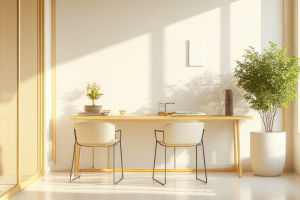Negative space—the “empty” areas around your furniture and décor—isn’t just blank. It’s doing some serious work to make your space feel airy, calm, and visually balanced.
In this guide, we’ll explore how you can use negative space to your advantage, helping your home feel more open without sacrificing style.
Understanding Negative Space
Let’s start by making friends with empty space. It’s not about taking everything away—it’s about choosing what truly matters and letting it shine.
Why Less Feels Better
When every corner is filled, the eye doesn’t know where to land. But when you give each item some breathing room, your space feels more focused and inviting. Negative space helps reduce visual stress, makes rooms appear larger, and brings attention to what is there.
Think about your favorite gallery or store display—what makes it appealing is usually the clean layout, not just the objects themselves.
Start with a Clean Slate
If your space feels crowded, take a moment to reset. You don’t need to toss anything—just move everything out of one section and slowly bring items back. Try placing only a few essentials, and observe how the empty space around them creates balance.
It’s a fun way to play with your layout without buying a thing. You’ll be surprised how a single chair or lamp can look completely different when it’s given room to breathe.
Let Your Walls Speak
Don’t feel like you need to cover every wall. Leaving some walls bare (or lightly decorated) gives your room an airy feel. If you do hang artwork, let it stand out by not crowding it with too many pieces side by side.
Think of it as setting a stage—your art becomes the star when there’s negative space around it to highlight its shape, color, or message.
Creating Space with Intention
Now that you’re on board with letting space do its thing, let’s make it practical. Here’s how you can create an uncluttered look that still feels cozy and lived in.
Choose Fewer, Stronger Pieces
It’s tempting to layer lots of small items, but often, a larger statement piece does more for the room. Instead of five tiny planters, maybe one sculptural vase is all you need. Instead of a pile of throw pillows, a well-placed one in a bold color might say more.
This doesn’t mean you have to go minimalist—it just means selecting what really fits the mood you’re after and letting each choice count.
Mind the Gaps (and Keep Them)
Gaps between furniture, floor space under tables, and open corners can be powerful design tools. Don’t rush to fill them. These “empty” areas give your room flow and make it easier to move both physically and visually.
A good test: stand at the entrance of your room. If your eyes can move across the space smoothly without stopping at every single object, you’re on the right track.
Edit As You Go
Design isn’t one-and-done. It’s okay to rotate items seasonally, remove something when it feels out of place, or just decide that a surface looks better with nothing on it at all.
Over time, your eye will start recognizing what feels “cluttered” and what feels intentional. Trust that instinct, and allow negative space to evolve naturally in your home.
Dear Lykkers, creating a home that feels open and peaceful doesn’t require a full redesign. It’s about giving your favorite things room to breathe—and understanding that what you don’t put in your space is just as powerful as what you do.
Let empty corners stay empty. Let your walls have a little pause. And let yourself enjoy a space that’s full of light, balance, and quiet beauty. You’ll start to see negative space not as “nothing,” but as the magic that makes everything feel just right.


